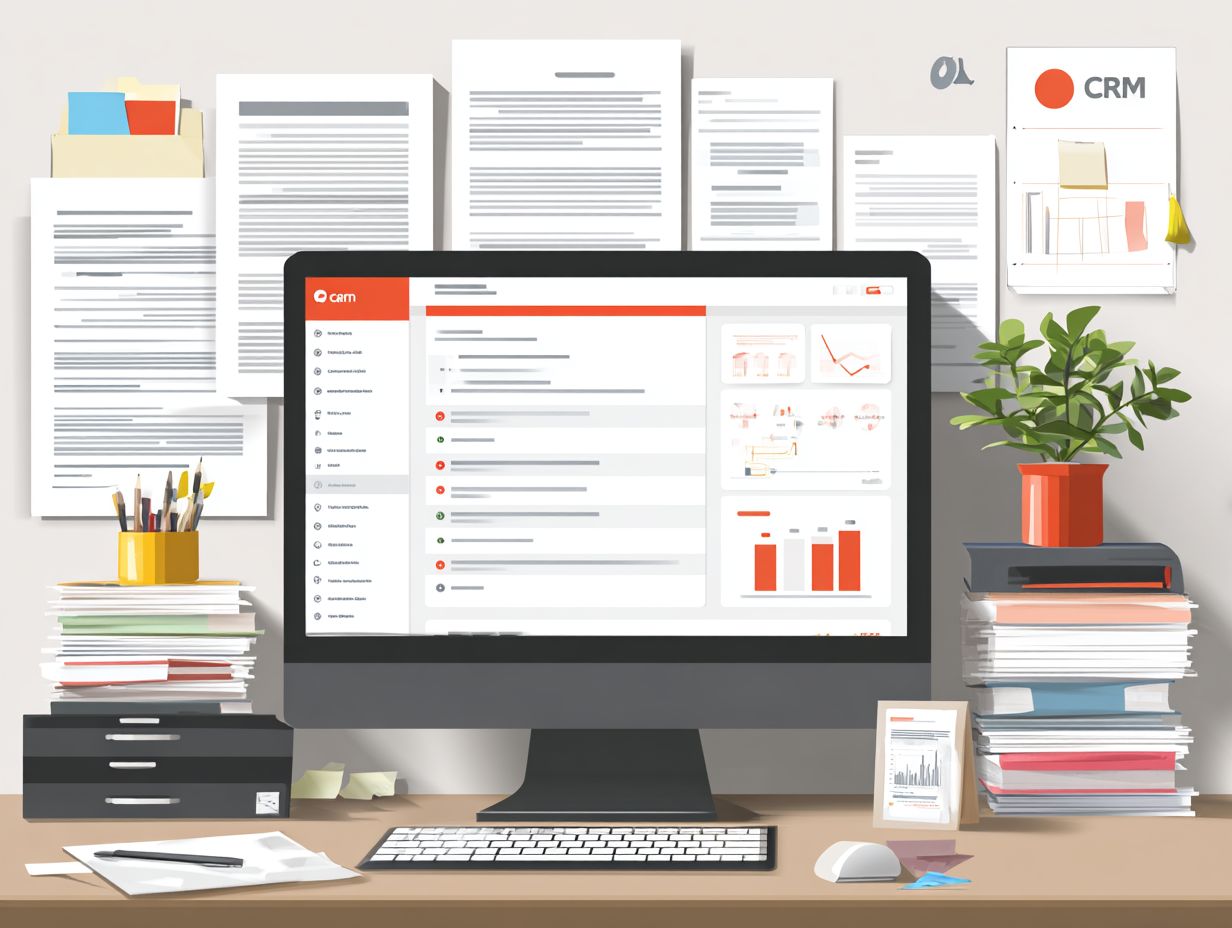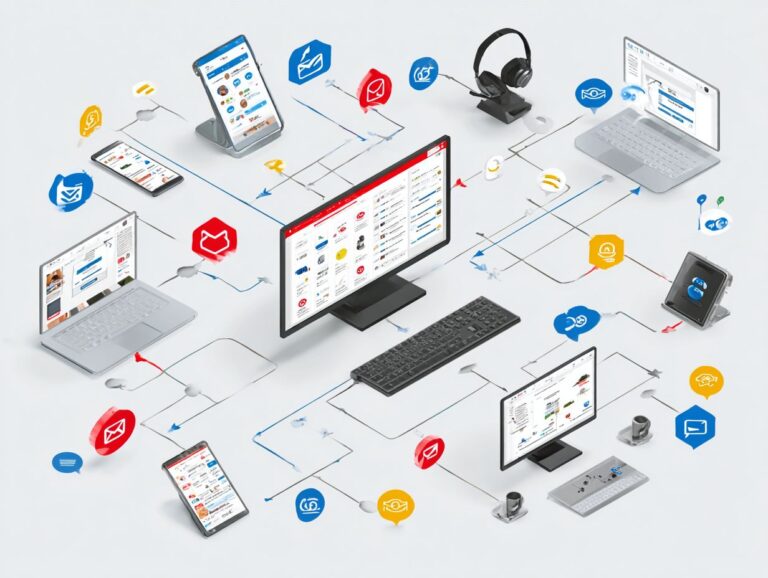Document Management and CRM Integration: Benefits and Best Practices
Combining document management systems with customer relationship management tools can change the way organizations work. This strong mix makes businesses work better and organizes tasks, allowing teams to quickly get important information. In this article, we will look at the advantages of this integration and provide practical tips to help your organization reach its full potential. Prepare to greatly increase your productivity and make communication better, changing the way you handle documents and interact with clients.
Key Takeaways:
- Integrating Document Management and CRM can improve efficiency, collaboration, and data security.
- It is important to carefully choose the right tools and technologies and establish clear objectives for successful integration.
- Training and managing changes are important for effectively using combined DMS and CRM systems.
- 1. Overview of Document Management Systems (DMS)
- 2. Overview of Customer Relationship Management (CRM) Systems
- Benefits of Integrating Document Management with CRM
- Best Practices for Integration
- Case Studies and Success Stories
- Frequently Asked Questions
- 1. What is the purpose of integrating document management and CRM?
- 2. How does document management and CRM integration benefit businesses?
- 3. What are some best practices for document management and CRM integration?
- 4. Can any document management and CRM systems be integrated?
- 5. How can document management and CRM integration improve customer experience?
- 6. Can document management and CRM integration be customized for specific business needs?
1. Overview of Document Management Systems (DMS)

Document Management Systems (DMS) are designed to manage the creation, storage, and retrieval of digital documents, improving operational efficiency significantly.
Key features of effective DMS include document tracking, which allows users to monitor changes and access history, and version control, ensuring that the latest updates are used.
It’s very important to follow security rules, especially in areas that handle confidential information. Tools like DocuWare, starting at around $300 per month, offer strong security and automatic features.
M-Files, with a similar price, focuses on working well with current workflows for an easier user experience. Selecting the right DMS depends on specific organizational needs and the scale of document handling.
2. Overview of Customer Relationship Management (CRM) Systems
Customer Relationship Management (CRM) systems facilitate the management of customer interactions, aiding sales teams in tracking performance and improving customer satisfaction.
Well-known CRM tools such as Salesforce and HubSpot provide strong solutions customized for various business needs. Salesforce costs $25 per user each month. It helps companies handle leads, organize tasks automatically, and study how customers act.
HubSpot, on the other hand, offers a free tier ideal for startups, with paid plans beginning at $45 per month, providing tools for email marketing and automation. Both platforms connect with various apps to maintain an efficient workflow between marketing and sales. They also offer detailed data analysis to help with making decisions.
For an extensive analysis of how customer experience impacts CRM effectiveness, our comprehensive study on customer experience marketing examines strategies to boost sales and retention.
Benefits of Integrating Document Management with CRM
Connecting Document Management with CRM gives organizations real advantages, such as better workflow efficiency and stronger data security.
1. Improved Efficiency and Productivity
Linking DMS with CRM can cut document search time by 70%, greatly increasing productivity for sales teams. To achieve this, companies should consider tools like DocuWare or M-Files, which seamlessly connect with popular CRMs such as Salesforce.
- Start by mapping existing document workflows to identify bottlenecks.
- Add automatic tagging and indexing to make documents simple to find in the CRM.
- Training sessions for team members can help everyone learn the new system and stay engaged.
As a case study, Company X reduced their document retrieval time from 30 minutes to 9 minutes per request after implementing DocuWare, exemplifying substantial efficiency gains.
2. Better Teamwork and Communication
A combined DMS and CRM helps teams work together instantly, enabling smooth sharing of documents and steady communication.
Tools like Microsoft Teams and Slack improve teamwork by directly connecting with Document Management Systems (DMS). Teams users can access SharePoint documents straight in the chat, which makes tasks easier. According to a report by McKinsey, using collaboration tools can increase productivity by up to 25%.
Connecting these tools with CRM systems like Salesforce lets teams share customer information immediately, leading to faster responses and better decisions. The combination of these technologies creates a more agile and responsive team environment.
3. Better Data Management and Security

Using a Document Management System (DMS) with Customer Relationship Management (CRM) helps manage information better by ensuring it’s accurate and reducing security risks related to handling documents. This integration provides specific security advantages such as unique permissions, where only designated team members can access sensitive documents.
The approval processes built into DMS systems help maintain oversight, ensuring that all changes are tracked and approved, further reducing security risks. Compliance is another important advantage; for example, connecting with systems that follow GDPR makes sure your data management meets European privacy rules.
In industries regulated by HIPAA, combining a secure document management system with a customer relationship management system can simplify handling patient information while keeping it compliant.
Best Practices for Integration
To effectively combine Document Management and CRM, it’s important to follow specific best practices that encourage success and user acceptance. If you’re curious about how technology elevates customer experience in these systems, you might find our insights on Customer Experience And Technology enlightening.
1. Choosing the Right Tools and Technologies
Choosing the right tools is important for combining systems; a common option is connecting SharePoint with Salesforce for managing documents. Connecting SharePoint with Salesforce can improve how documents are managed and make workflows more efficient.
Start using Microsoft Power Automate to create systems that keep files updated between the two platforms. For example, automatically save attachments from Salesforce emails to a specific SharePoint document library.
Use tools like Zapier to handle more involved connections; it lets you create actions, such as updating Salesforce records when a SharePoint document changes. Focus on ease of use and the ability to expand when choosing these tools, so they can evolve as your organization requires.
2. Establishing Clear Objectives and Goals
Defining clear objectives and goals for the integration process is essential to track performance and measure success effectively.
To set specific goals, start by setting clear targets, like increasing user interaction by 20%. Make sure these are measurable using tools like Google Analytics to track page views and bounce rates.
Next, make sure these goals are realistic; for example, set a target for a 5% monthly growth instead of an unrealistic 50%. Confirm relevance by aligning goals with overall business objectives, such as improving customer satisfaction. Set a time frame-assess progress monthly to stay on track and adjust strategies as needed.
3. Training and Change Management
Good user training and change management strategies help staff get used to new combined systems smoothly. To achieve successful user training, consider implementing a combination of workshops, e-learning platforms, and hands-on sessions.
- Start with a week-long workshop to introduce the new system.
- Then, spend a month on online learning modules to learn more.
- Schedule regular feedback sessions to address concerns and reinforce learning.
Ideally, aim for a three-month timeline, allowing gradual, consistent exposure while providing ongoing support through FAQs and peer mentoring. This method builds user confidence and improves the success of integration.
Case Studies and Success Stories

Looking at real-world case studies shows the clear benefits companies have gained through good document management and CRM integration.
1. Real-world Examples of Successful Integrations
One notable success story is that of XYZ Corp, which achieved a 40% reduction in client onboarding time by integrating Document Management with their CRM system.
Similarly, ABC Inc. used SharePoint for handling documents and Salesforce as their customer relationship management system. This integration led to a 25% increase in sales team productivity, as accessing client documents became seamless.
DEF Ltd. using Zoho Docs together with Zoho CRM led to a 30% rise in customer satisfaction scores because queries were resolved more quickly. Important takeaways from these companies are focusing on teaching users how to use the tools and keeping strong data security measures during the changeover.
2. Upcoming Developments in Document Management and CRM Integration
Upcoming patterns suggest an increase in using automation and advanced data analysis in combining Document Management and CRM systems. Organizations can adjust to these trends by using AI-powered document tools like DocuSign or Adobe Sign, which make approval processes faster and cut down on mistakes.
Using analytics tools like Tableau or Google Data Studio can help make better decisions by showing how customers interact and how documents are used.
To stay ahead, companies should invest in teaching their employees about these tools, ensuring they know how to use them correctly. Regularly checking and improving these systems will help stay competitive as things change.
Frequently Asked Questions
1. What is the purpose of integrating document management and CRM?
Linking document management with CRM makes handling customer data and documents easier and faster. It also helps to improve accessibility and accuracy of information, leading to better customer relationships and business growth.
2. How does document management and CRM integration benefit businesses?
By integrating document management and CRM, businesses can save time and resources by eliminating duplicate data entry and manual document filing. It also helps to improve collaboration and communication among team members, leading to increased productivity and improved customer service.
3. What are some best practices for document management and CRM integration?
Some best practices for document management and CRM integration include defining a clear data management strategy, regularly cleaning and updating data, and ensuring data security and privacy. It’s also important to teach employees how to use the system correctly and regularly check and improve processes.
4. Can any document management and CRM systems be integrated?
It’s crucial that document management and CRM systems can connect smoothly and have simple integration steps. It’s a good idea to get help from a professional for smooth integration.
5. How can document management and CRM integration improve customer experience?
When businesses keep customer details and files in one place that’s easy to search, they can respond to customer questions quickly and provide service suited to each person. This improves overall customer experience and satisfaction.
6. Can document management and CRM integration be customized for specific business needs?
Yes, document management and CRM integration can be customized based on specific business needs, such as automating certain processes or creating custom fields and workflows. This enables a better fit with the specific needs of the business.





